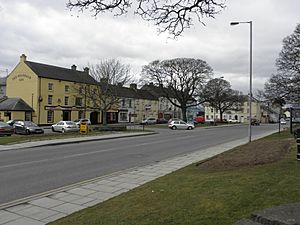Moy, County Tyrone facts for kids
Quick facts for kids Moy
|
|
|---|---|
 |
|
| Population | 1,598 (2011 Census) |
| Irish grid reference | H7962 |
| District |
|
| County | |
| Country | Northern Ireland |
| Sovereign state | United Kingdom |
| Post town | Dungannon |
| Postcode district | BT71 |
| Dialling code | 028 |
| EU Parliament | Northern Ireland |
| UK Parliament |
|
| NI Assembly |
|
| Website | moyni.weebly.com |
Moy (which means "the plain" in Irish) is a small village and townland in County Tyrone, Northern Ireland. It is located about 5 miles (8 km) southeast of Dungannon. Moy sits right next to a smaller village called Charlemont.
Charlemont is on the east side of the River Blackwater. Moy is on the west side. The two villages are connected by Charlemont Bridge. This river also forms the border between County Tyrone and County Armagh. In 2011, about 1,598 people lived in Moy.
Contents
Exploring Moy's Past
Moy has a rich history. Many of the houses around the village square were built in the mid-1700s. The village is home to four different churches: Roman Catholic, Church of Ireland, Presbyterian, and Methodist. These churches were built a bit later than the houses.
Moy During the Troubles
Like many places in Northern Ireland, Moy experienced a difficult period known as "The Troubles". This was a time of conflict and tension that affected communities across the region. People in Moy faced many challenges during these years. The village worked hard to overcome these difficulties and build a peaceful future.
Moy's Railway History
Long ago, Moy was connected by railway. The Portadown, Dungannon and Omagh Junction Railway opened a section in 1858. The closest station to Moy was called Trew and Moy. However, it was actually over 2 miles (3 km) north of the village, at Trew Mount.
Later, in 1876, this railway became part of the Great Northern Railway. The Ulster Transport Authority took over the line in 1958. Sadly, the railway line near Moy closed down in 1965.
Places to See in Moy
Moy has some interesting historical features. For example, a famous iron-founder named Richard Turner designed a special glass building called a conservatory for a house in Moy around 1850.
Sports and Activities
Moy has a strong tradition of sports, especially horse riding and Gaelic games. The local Gaelic football team, Moy Tir Na nOg, achieved great success. They became the All Ireland Intermediate Club Champions in 2018. This was a big achievement for the village!
Schools in Moy
Moy has two primary schools for younger students:
- Moy Regional Primary School
- St. John's Primary School, Moy
Moy's Population and People
The Northern Ireland Statistics and Research Agency (NISRA) considers Moy a village. This means it has between 1,000 and 2,499 people. On March 27, 2011, the population of Moy was 1,598.
Here are some facts about the people living in Moy in 2011:
- About 25% of the people were under 18 years old.
- About 11% of the people were 65 years old or older.
- The population was almost evenly split between males (about 49%) and females (about 52%).
- Most people (about 74%) were from a Catholic background.
- About 22% were from a Protestant or other Christian background.
- When asked about their nationality, about 22% said British, 40% said Irish, and 29% said Northern Irish.
Famous People from Moy
Moy has been home to several notable people:
- Ryan Kelly: A singer and songwriter who grew up in Moy. He is a member of the popular Irish band Celtic Thunder.
- John King: A famous explorer who traveled in Australia.
- Gerry McKenna: A respected biologist and academic. He was the Senior Vice President of the Royal Irish Academy and also the Vice Chancellor and President of the University of Ulster.
- Paul Muldoon: A well-known poet who was born and grew up in Moy. He often mentions the village in his poems.
See also
 In Spanish: Moy para niños
In Spanish: Moy para niños


